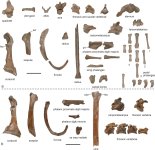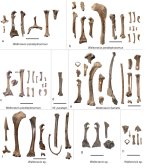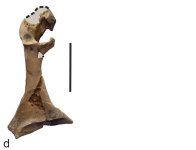Fred Ruhe
Well-known member

Gerald Mayr & Andrew C. Kitchener, 2022
New species from the early Eocene London Clay suggest an undetected early Eocene diversity of the Leptosomiformes, an avian clade that includes a living fossil from Madagascar
Palaeobiodiversity and Palaeoenvironments. doi:10.1007/s12549-022-00560-0
Abstract and free pdf: https://link.springer.com/content/pdf/10.1007/s12549-022-00560-0.pdf?pdf=button
We report the first records of the leptosomiform taxon Plesiocathartes from the early Eocene London Clay of Walton-on-the-Naze (Essex, UK). Two species could be distinguished, one of which is described as Plesiocathartes insolitipes, sp. nov. (the other is classified as Plesiocathartes sp.). We furthermore describe two small leptosomiform-like birds from Walton-on-the-Naze, Waltonavis paraleptosomus, gen. et sp. nov. and W. danielsi, gen. et sp. nov., which are represented by partial skeletons of multiple individuals. In plesiomorphic characters of the coracoid and furcula, the new taxon Waltonavis is distinguished from Plesiocathartes and the extant Leptosomus; the skull of Waltonavis furthermore exhibits basipterygoid processes, which are absent in Leptosomus. Another new species, Lutavis platypelvis, gen. et sp. nov., is based on a partial skeleton from Walton-on-the-Naze and closely resembles Plesiocathartes in the overall shape of the tarsometatarsus. However, L. platypelvis is clearly distinguished from leptosomiform birds in the morphology of the hypotarsus, the more massive coracoid, and other skeletal features. Although we consider close affinities to Plesiocathartes and, hence, the Leptosomiformes to be possible, we could not identify derived characters that enable an unambiguous phylogenetic placement of L. platypelvis. In any case, the new species document an unexpected diversity of Plesiocathartes-like fossil in the London Clay and may open a new perspective for a reconstruction of the ancestral morphology of the avian clade Afroaves, which includes the Leptosomiformes and other arboreal landbirds.
Enjoy,
Fred
New species from the early Eocene London Clay suggest an undetected early Eocene diversity of the Leptosomiformes, an avian clade that includes a living fossil from Madagascar
Palaeobiodiversity and Palaeoenvironments. doi:10.1007/s12549-022-00560-0
Abstract and free pdf: https://link.springer.com/content/pdf/10.1007/s12549-022-00560-0.pdf?pdf=button
We report the first records of the leptosomiform taxon Plesiocathartes from the early Eocene London Clay of Walton-on-the-Naze (Essex, UK). Two species could be distinguished, one of which is described as Plesiocathartes insolitipes, sp. nov. (the other is classified as Plesiocathartes sp.). We furthermore describe two small leptosomiform-like birds from Walton-on-the-Naze, Waltonavis paraleptosomus, gen. et sp. nov. and W. danielsi, gen. et sp. nov., which are represented by partial skeletons of multiple individuals. In plesiomorphic characters of the coracoid and furcula, the new taxon Waltonavis is distinguished from Plesiocathartes and the extant Leptosomus; the skull of Waltonavis furthermore exhibits basipterygoid processes, which are absent in Leptosomus. Another new species, Lutavis platypelvis, gen. et sp. nov., is based on a partial skeleton from Walton-on-the-Naze and closely resembles Plesiocathartes in the overall shape of the tarsometatarsus. However, L. platypelvis is clearly distinguished from leptosomiform birds in the morphology of the hypotarsus, the more massive coracoid, and other skeletal features. Although we consider close affinities to Plesiocathartes and, hence, the Leptosomiformes to be possible, we could not identify derived characters that enable an unambiguous phylogenetic placement of L. platypelvis. In any case, the new species document an unexpected diversity of Plesiocathartes-like fossil in the London Clay and may open a new perspective for a reconstruction of the ancestral morphology of the avian clade Afroaves, which includes the Leptosomiformes and other arboreal landbirds.
Enjoy,
Fred






